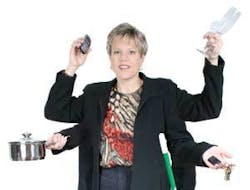Are You Prey to the failure patterns of Women Dentists?
Being a professional woman, I know we are often expected to be all things to all people at all times. As the head of a company, mother of teenage daughters, and semidecent wife when I’m not asleep, I can tell you, it’s a tall task to be superwoman. This is particularly true for women dentists who often take on the roles of mother, wife, business owner, caregiver, patient counselor, staff nurturer, etc.
Four management mysteries keep professional women down. Once we unlock them, we can shed the lead weights from our feet and soar toward success in all areas of our lives. The mysteries lie in management of staff, patient, cash-flow, and most important, life.
Staff management entails setting your vision and priorities and learning how to be friendly while remaining professional. Patient management involves attracting the kind of patients you want, then inspiring them to embrace your vision for ideal care. Cash-flow management means achieving the lifestyle you desire from your practice while funding your retirement, whether it be five, 10, 20, or more years away. Life management means getting what you want without having to be a superhero. Let’s look at each of these mysteries.
Staff management
One of the biggest challenges for women in dentistry is to summon their knowledge, intentions, and self-esteem to design their dental practices to match their needs and desires. Too many women set “Miss America,” politically correct visions (“I want to help the children of the world”), or old-world martyr-mother visions (“It’s OK. I’m here to serve everyone else. I don’t need anything”).
When we follow the Miss America vision, we speak rhetoric to make people think we’re good. In truth, this vision doesn’t meet our needs. The martyr-mother vision, similarly, means designing our businesses to suit everyone’s needs but our own. Neither approach will last long without our feeling resentment, discouragement, stress, and frustration at not getting what we want, ultimately leading to burnout.
Women dentists in particular are vulnerable to this mindset because they think that being a professional caregiver means they must be Mother Teresa. There is no reason why a woman dentist can’t trust her vision and values enough to want to be a financial success and accomplish it in a way that benefits her staff, patients, family, and everyone she touches.
Your practice, which is your life’s work, must aim for goals that serve you, the owner-leader. How do you set a vision that meets your needs? Look 12 months ahead and ask yourself: What do I really want from my practice? Examine profitability, treatment and outcomes, service and quality of care, staff performance, schedules, and a balance of professional and personal life that makes you happy and productive. If you fail to begin each year with a specific vision of tangible outcomes that you want to accomplish and a map to achieve them, you will end up serving other people’s goals - like the martyr-mother who sits alone in the dark eating crumbs.
Once you find the courage to create a vision that supports you, drop the restrictive leadership roles that women dentists in particular can adopt. Too many women run their practices like sororities. The intense desire to be liked and supported by your staff can make you soft on standards, which creates a chaotic work environment that leads to frustration and dissatisfaction for you and the team. Be supportive of your staff, but don’t let them hold you hostage. You can achieve this balance when staff members desire to be in their jobs a little more than you desire them to be.
True freedom and self-direction for the staff come from your setting black-and-white expectations for job performance, then communicating clearly when that performance exceeds or falls short of the standards. It isn’t always easy for women dentists to pull back on the nurturing. Nevertheless, security for your staff does not come from coddling them, but from giving them directions and goals with the freedom to choose to meet them or not. The most liberating leadership stand you can take for yourself and your team is to tell them, “This is what I need. This is what I’m getting. You are at a choice point.”
For example, “I need all staff to arrive on time every day for the morning huddle. Last month there was consistent lateness, which violates our practice vision of maintaining a daily exchange of information among us for a seamless delivery of service. Therefore, I need your commitment to arrive on time.” The latecomers are at a choice point.
Patient management
Once you influence and inspire the staff (your internal customers) to want to do what you want them to do, the next management mystery lies in doing the same thing with patients (your external customers). Again, it can be difficult for female dentists to act assertively, especially if they have been conditioned by cultures around them to adopt the more traditionally feminine traits of being congenial and accommodating.
Can you look directly into a patient’s eyes, whether male or female, and tell the person, “Even though your insurance doesn’t cover a three-month hygiene visit, it’s necessary that you have this, or we will compromise your clinical care.”
Many female doctors cannot do this for the same reasons they falter in managing staff -they want to be liked, to be approved of, and to avoid conflict. But patients deserve dentists who are strong advocates for their long-term oral health. Ultimate respect and popularity come from serving your patients’ needs well.
Part of achieving your vision lies in identifying clearly the type of patient you want. Women dentists need to guard against assuming the traditional female role of being mother to all. We’ve been conditioned not to favor one of our children over another, but in our professional lives, we can and should favor customers who best match our business philosophies.
Do you know who your ideal patient is? What kind of person fulfills your vision, values, and goals? Do you have the courage to say no to being all things to all people? Do you want to attract people of a certain age or gender? Or those with certain kinds of dental needs and desires? Families? Young professionals? Think about the patients you enjoy treating because their needs and desires match your vision. It is your job to define the characteristics of your ideal patient and to gear all marketing efforts toward attracting them.
For example, if you enjoy working with entire families, then your Yellow Pages ad, if you use one, should feature a family and carry a message that speaks to them.
Once you attract patients who match your ideal profile, you again need the verbal skills of influencing. By engaging patients in co-diagnosing their conditions during clinical exams and presenting treatment in a way that lets them partner with you in discussing and choosing the best care, you can influence them to make the best choices for their oral health. However, influencing patients requires that you give them direction and not fall prey to the more traditional feminine behavior patterns of congeniality and unassertiveness, which can compromise your standards of care.
Cash-flow management
Now that we discussed how to create an environment where staff and patients align with your vision and values, let’s turn to the third management mystery. This one is sometimes perceived as the unwholesome mystery: cash-flow management. Are you comfortable with being hugely profitable? Or do you feel that a concern for profit conflicts with your goals as a caregiver? An entrepreneur is someone who takes the risk of investing and expects a return, so it’s necessary for the woman dentist to feel comfortable with being extremely profitable and financially successful.
One of my favorite teaching examples, which can strike fear in my clients, compares the financial picture of a dentist straight out of dental school with that of a telephone installer who immediately starts working for the phone company at age 18. It would take the dentist 20 years of grossing $150,000 a year in salary to catch up to the telephone installer in wealth accumulation. What are the factors that create this dismal statistic? The cost of schooling for the dentist, the lost years of revenue, the expense of a practice purchase or start-up, the higher tax bracket of the dentist, and most important, the head start that the telephone worker has in accumulating retirement savings, as a company benefit, from the moment he or she begins work. Dentists - male or female - are amazed at the cost of the investments they make in their careers. We at Pride consider dentistry a noble profession and think it is OK for dentists to catch up with telephone employees and surpass them. Because women have traditionally made less money than their male counterparts in many professions, female dentists must feel comfortable knowing that a DDS or DMD degree brings with it the permission to make as much money as their male colleagues - or more.
Some women dentists who have spouses contributing to their incomes demand less of a return from their practice investments than they should. This may be because of a reluctance to make more money than a spouse or a complacency with having just what is needed and no more. As a professional, your practice should be able to meet all your needs. It should fund your cash-flow requirements and give you the lifestyle you deserve, as well as provide insurance coverage, savings for retirement, college and weddings for the kids, and funds to reinvest in new technology and education to remain state-of-the-art. Your practice should fund all of this without your needing a partner or spouse’s help.
How do you accomplish that? Each year, when you create a vision for what you want to accomplish in your practice, compose what I call a holiday wish list. This is an itemized list of the personal and business expenses that you forecast for the next 12 months - staff salary increases, new equipment purchases, retirement savings, and a raise for the doctor (don’t forget, you need to catch up to the telephone company employee). Backtrack from this list to identify the production and collection goals that will net you the cash flow to pay for these expenses. Then you can design a strategy with your team to meet those goals.
This process works. In consulting with hundreds of dental practices, we discovered that just having a goal - be it production per hour, per day, or per year - can increase returns by up to 25 percent. Why? Because what gets focused on, gets done. If you incorporate systems, staff, and other operational improvements to attain your goals, the results are more spectacular.
Life management
Now that we’ve solved the mysteries of staff, patient, and cash-flow management, we’re left with the biggest and most dramatic one: life management. I often see female dentists burdened with the myth of superwoman. Who remembers the jingle, “I can bring home the bacon/fry it up in a pan/and never let you forget that you’re a man/’cause I’m a wo-man … . ” How many women attempt to be a superdentist, supermom, and superwife, only to burn out? When a woman dentist asks me how she can be superwoman - how she can care for three children under age 5, increase her production by 50 percent, transform her practice into a digital office, and do it all at once - my answer is simple: Take off the cape. Don’t try to be superwoman. As is the case with any entrepreneur, you can’t do everything perfectly at the same time. Different stages of your life will bring different priorities. You cannot make everything a priority, because then you will fail in something.
For example, when raising a family, it is OK to make your personal life your top priority and adjust your practice to accommodate that. The years when your children are young may not be the same years in which you will see a 50-percent growth in your practice. This may be the time when you work less and produce at a more modest level, but you can still meet your basic needs. The impulse to do everything at once can result in your being mediocre at all of the things that matter to you.
I counsel female dentists who, during their child-raising years, adopt space-sharing arrangements with other dentists or take on associates to limit their time in the office to two or three days a week. With maximum efficiency of systems, they can make all the money they need at that life stage. Then, when their children are older, they significantly increase their office schedules and production. (As a mother of teenagers, I look forward to leaving the house to go to work.) The most important lesson to learn in balancing your life is that there is no cookie-cutter solution for all women. You need to decide what schedule works for you.
We find that an ideal schedule for a well-managed, solo practice in peak performance is no more than 172 days a year of work and with a spectacular production of $1 million or more. How many days will you work this year? If it’s more than 172, you might still be wearing your cape. Take it off. You’re a hero already. Increase the return from your practice by working smarter, not harder.
As a businesswoman who lives with these issues every day and who helps women dentists realize their visions, I can tell you that it is feasible to have the practice of your dreams that supports your personal goals and lifestyle. It’s possible if you’re courageous enough to solve the four mysteries. This means coming to grips with your relationships with others, your business and financial needs, and your priorities. You are the architect of your own future. Why not build the most beautiful practice you can imagine? Now, that’s not superhuman; it’s super-smart.
Amy Morgan
Morgan is CEO and lead trainer of Pride Institute, an international dental management consulting firm. For 18 years, she has consulted hundreds of doctors to end cash-flow crises and improve practice management. For more information, call (800) 925-2600.





